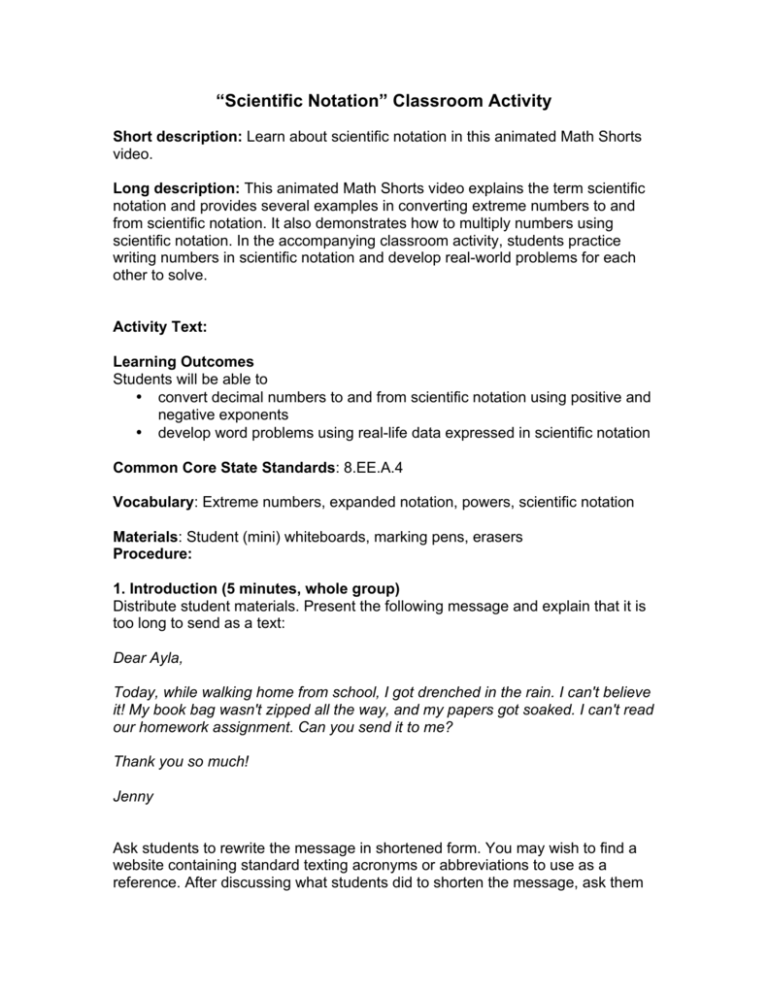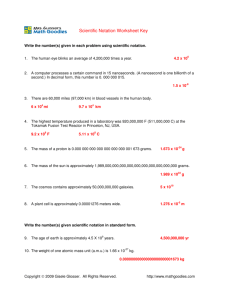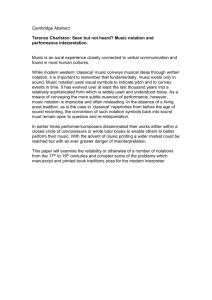“Scientific Notation” Classroom Activity
advertisement

“Scientific Notation” Classroom Activity Short description: Learn about scientific notation in this animated Math Shorts video. Long description: This animated Math Shorts video explains the term scientific notation and provides several examples in converting extreme numbers to and from scientific notation. It also demonstrates how to multiply numbers using scientific notation. In the accompanying classroom activity, students practice writing numbers in scientific notation and develop real-world problems for each other to solve. Activity Text: Learning Outcomes Students will be able to • convert decimal numbers to and from scientific notation using positive and negative exponents • develop word problems using real-life data expressed in scientific notation Common Core State Standards: 8.EE.A.4 Vocabulary: Extreme numbers, expanded notation, powers, scientific notation Materials: Student (mini) whiteboards, marking pens, erasers Procedure: 1. Introduction (5 minutes, whole group) Distribute student materials. Present the following message and explain that it is too long to send as a text: Dear Ayla, Today, while walking home from school, I got drenched in the rain. I can't believe it! My book bag wasn't zipped all the way, and my papers got soaked. I can't read our homework assignment. Can you send it to me? Thank you so much! Jenny Ask students to rewrite the message in shortened form. You may wish to find a website containing standard texting acronyms or abbreviations to use as a reference. After discussing what students did to shorten the message, ask them for examples of other words, phrases, or names that are shortened (for example, NBA for National Basketball Association, Dr. for Doctor, and AK for Alaska). Ask, Why do we shorten these? Explain that in mathematics and science, very large or extreme numbers are also shortened. 2. Writing Numbers in Different Ways (5 minutes, pairs) Present the following information, asking students to say the statements aloud to a partner: • The population of the world is about 7,117,000,000. • The distance from Earth to the Sun is about 92,960,000 miles. • The human body contains approximately 60,000,000,000,000 to 90,000,000,000,000 cells. • The mass of a particle of dust is 0.000000000753 kg. • The length of the shortest wavelength of visible light (violet) is 0.0000004 meters. Discuss the numbers and then assign one or two of them to each pair to rewrite in different ways, such as in words, expanded notation, and powers. Circulate through the room and check for understanding. 3. Scientific Notation (5 minutes, whole group) Explain to students that there is an easier way to write and say these numbers. Scientific notation is a system developed by scientists and mathematicians to express very large or extreme numbers. Next, show students the video. 4. Writing Numbers in Scientific Notation (10 minutes, pairs) After watching the video, have students return to the previous numbers, writing them in scientific notation. • The population of the world is about 7,117,000,000. (Answer: 7.117 x 109) • The distance from Earth to the Sun is about 92,960,000 miles. (Answer: 9.296 x 107) • The human body contains approximately 60,000,000,000,000 to 90,000,000,000,000 cells. (Answer: 6.0 x 1013 to 9.0 x 1013) • The mass of a particle of dust is 0.000000000753 kg. (Answer: 7.53 x 10-10) • The length of the shortest wavelength of visible light (violet) is 0.0000004 meters. (Answer: 4.0 x 10-7) After students have written out the numbers, have each pair create their own word problems using real-life numbers expressed in scientific notation. You can have them explore various Web sites containing statistical information or look through newspapers to find the numbers. Conclusion (5 minutes, whole class) Review the process of converting numbers to and from scientific notation based on any misconceptions you may have observed, such as moving the decimal in the correct directions when using positive and negative powers. Activity Extension: As an introduction to adding, subtracting, multiplying, and dividing numbers in scientific notation, have students work on solving the word problems that each pair of students created. As a group, explore the ways students went about solving these word problems.








